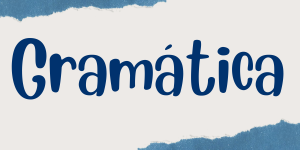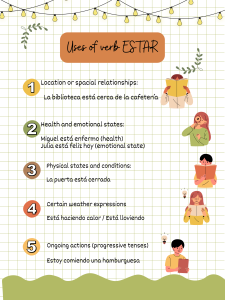Present of verb ESTAR / Present of the verb estar

Ser and Estar both mean “to be” in English, but both are used differently depending on what the speaker intends to address. Below you will find how estar is conjugated and when to use this verb.
Verb ESTAR (to be)
| Singular | Plural |
| Yo- Estoy | Nosotros/as- Estamos |
| Tú- Estás | Vosotros/as- Estáis |
| Él/Ella/Usted- Está | Ellos/Ellas/Ustedes- Están |

PRÁCTICA
Now that you have learned about the present verb estar, let’s practice;
Ejercicio 1
Ejercicio 2
Licensing and Attribution:
Gramática content on this page was remixed from Español por el mundo by Gemma Morawski and Ani Alcocer, licensed under a Creative Commons Attribution 4.0 International License. Adaptations include voice pronunciations provided by Gemma Morawski and openly-licensed images throughout the H5P flashcards attributed on each card via the H5P editing dashboard and forvo.com . Further adaptations include practice activities created by Gemma Morawski via H5p. Activities were remixed from the following sites;
Ser-Estar is shared under a not declared license and was authored, remixed, and/or curated by LibreTexts.
9.14: Ser versus estar is shared under a CC BY-NC-SA 4.0 license and was authored, remixed, and/or curated by Erin Huebener (Independent) via source content that was edited to the style and standards of the LibreTexts platform.
Images wee created by Gemma Morawski with canva.com
